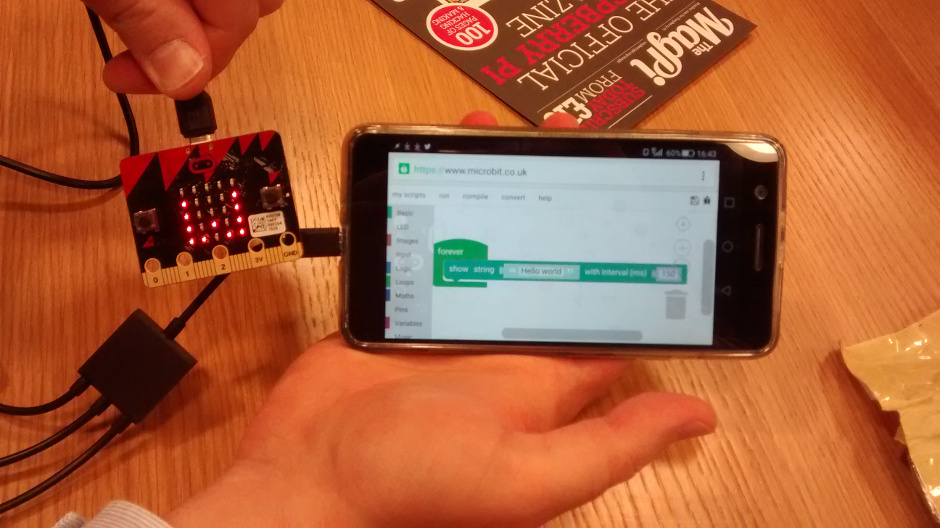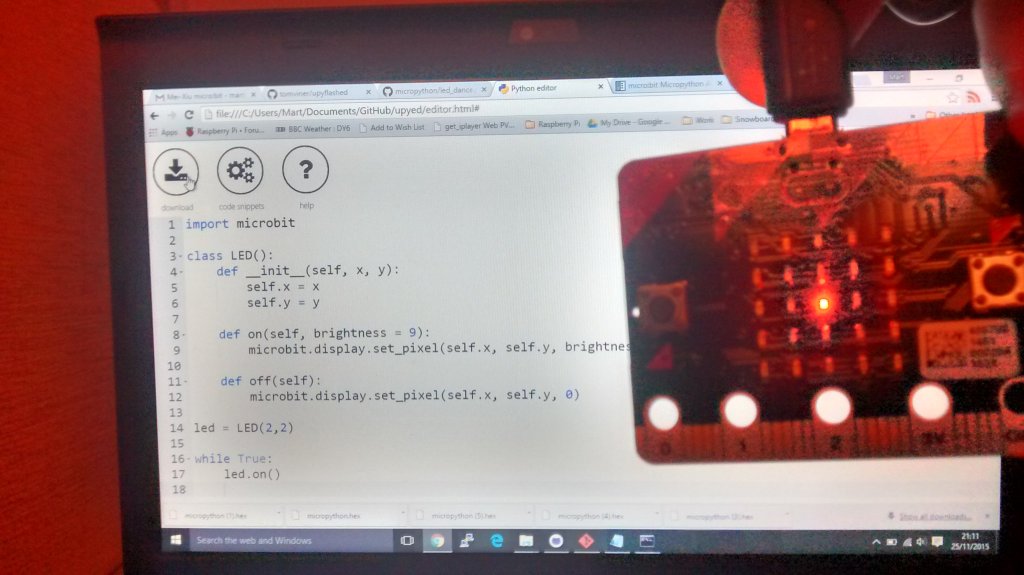Mei-Xiu micro:bit
Päivi Suomela Sheffield, UK.
Saturday, 9th January 2016
Finnish version
Mei-Xiu pimeni ja lakkasi toimimasta. Ei auta kuin palauttaa Mei-Xiu Nicholakselle ja olla iloinen että ehdin leikkiä sen kanssa edes vähän aikaa.
English version
Poor Mei-Xiu fizzled out I was debugging a script. It never came back so it will be sent back home to Nicholas. So sad!
Lue lisää: RIP Mei-Xiu
Read More: RIP Mei-Xiu
Päivi Suomela Sheffield, UK.
Saturday, 9th January 2016
Finnish version
Mei-Xiun viimeiseksi jääneessä projektissa harjoittelin summerin yhdistämistä GPIO-pinnin avulla. Projektissa käytin CamJam EduKitin mukana tulleita summeria, koekytkentälevyä ja johtoja. Koodin puolesta tämä projekti on hyvin yksinkertainen, pinni 1 joko lähettää virtaa summeriin (jolloin se pitää meteliä) tai sitten ei.
Tämä oli ensimmäisiä elektroniikkakokeiluja mitä olen tehnyt ja olen itsekin yllättynyt että se edes toimi :D.
English version
The last successful project with Mei-Xiu was a test to get a buzzer to work on button click. I used the buzzer, breadboard and jumper wires that came with CamJam EduKit and connected a buzzer to the Micro:Bit. The code itself is very simple, pin1 is either on and powering the buzzer, or it is off and and the buzzer is quiet.
I've never really worked with electronics so I am proud of myself for getting it to work!
Lue lisää: Projekti #3 - Summeri
Read More: Project #3 - Buzzer
Lähdekoodi githubissa / Code on github: buzzer.py
Päivi Suomela Sheffield, UK.
Thursday, 7th January 2016
Finnish version
Toisena projektina halusin kokeilla saanko pallon pomppimaan ruudulla. 5x5 näyttö oli aika pieni tarkoitukseen, mutta ainakin pallon liike onnistui sinne päin. Pallo jäi kuitenkin helposti jumiin samaan liiikerataan, joten lisäsin mahdollisuuden käyttää nappuloita x- ja y-koordinaattien muuttamisen jotta pallon sai liikkelle eri suuntaan. Palloja voi myös lisätä useamman painamalla molempia nappeja yhtäaikaa.
Valitettavasti Mei-Xiu päätti päivänsä ennen kuin kuvasin ohjelman, mutta onneksi Marja auttoi myöhemmin joten tässä esimerkki.
English version
In my next project I wanted to get a ball to bounce on the display. Turns out it is pretty tricky on 5x5 grid so the ball gets stuck in a rut quite easily. I added some options to change the x and y coordinates using the buttons so that the ball could be moved to a new trajectory. You can also add more balls by clicking both buttons at the same time.
Poor Mei-Xiu stopped working before I got this on video, but later Marja helped me to get an example which you can see above.
Lue lisää: Projekti #2 - Pomppiva Pallo
Read More: Project #2 - Bouncy Ball
Lähdekoodi githubissa / Code on github: bounce.py
Päivi Suomela Sheffield, UK.
Wednesday, 6th January 2016
Finnish version
Mei-Xiu saapui ja aloitin pienellä positiivisuusohjelmalla joka piirtää sydämiä.
English version
I received Mei-Xiu and started off with a little project to add positivity by a beating heart.
Lue lisää: Projekti #1:Awesome Hearts
Miniblogi kokonaisuudessaan: BBC Micro:bit -viikko
Read More: Project #1:Awesome Hearts
Full blog series: My Week with Micro:bit
Lähdekoodi githubissa / Code on github: awesome_hearts.py
Eleni Lixourioti London, UK.
Wednesday, 30st December 2015
Greek version
Καθώς δεν τα πηγαίνω γενικά πολύ καλά με την κηπουρική, πολλές φορές δυσκολεύομαι να κρατήσω τα φυτά μου χαρούμενα.
Για να διευκολύνω λίγο τα πράγματα, έφτιαξα την παρακάτω λύση:
English version
I'm not much into gardening and I often struggle to keep my indoor plants happy.
Here's what I came up with to make things a little easier:
Διάβασε την υπόλοιπη ανάρτηση (Read the post): Project #3: Plants have feelings too
Πλήρης σειρα (Full blog series): A week with Micro:bit
Κώδικας (Code on github): happy_plant.py
Eleni Lixourioti London, UK.
Wednesday, 30st December 2015
Greek version
Τα Χριστούγεννα (τουλάχιστον για όσους ζουν στο Βόρειο ημισφαίριο) συχνά συνδέονται με το χιόνι.
Σκέφτηκα λοιπόν να δημιουργήσω μερικές χιονονυφάδες στο microbit.
Αυτό κατέληξε να γίνει μια μικρή άσκηση περιστροφής γωνίας έτσι ώστε να γεμίσουμε συμμετρικά τον υπόλοιπο πίνακα με leds.
Τα αποτελέσματα... δε μοιάζουν και πολύ με νυφάδες ;)
English version
Since Christmas often means snow (at least for us living in the northern hemisphere) I thought to try to generate some snowflakes on the microbit.
This is just a small exercise of rotating a corner to symmetrically fill the rest of the leds. Results might be... not very snowflake-like ;)
Διάβασε την υπόλοιπη ανάρτηση (Read the post): Project #2: Snowflakes (almost)
Πλήρης σειρα (Full blog series): A week with Micro:bit
Κώδικας (Code on github): snowflakes.py
Eleni Lixourioti London, UK.
Wednesday, 30st December 2015
Greek version
Ταιριάζει για αρχή να ξεκινήσουμε με μια εφαρμογή που ρίχνει ζάρια!
Δυνατότητες:
- Τα κουμπιά πρέπει να αλλάζουν μεταξύ των διαθέσημων ζαριών ενός στάνταρ σετ για RPG (d4, d6, d8, d10, d12, d20)
- Μόλις ο παίκτης επιλέξει το ζάρι που θέλει, πρέπει να μπορεί να το ρίξει κουνώντας το micro:bit.
Δυσκολίες:
- Ανίχνευση της κίνησης "ριξήματος"
- Προσαρμογή ρυθμίσεων για βελτίωση της χρηστικότητας
English version
Obligatory dice rolling project to get us started!
Features:
- The buttons should cycle through the various dice from a simple standard RPG poly set (d4, d6, d8, d10, d12, d20)
- Once a die is selected the player should be able to roll it by shaking the micro:bit.
Challenges:
- Shake detection
- Calibration for usability
Διάβασε την υπόλοιπη ανάρτηση (Read the post): Project #1: Dice Roller
Πλήρης σειρα (Full blog series): A week with Micro:bit
Κώδικας (Code on github): dice_roller.py
Stewart Watkiss Redditch, UK.
Monday, 21st December 2015
The accelerometer on the micro:bit is a great way to control robots. The accelerometer is very easy to use in MicroPython, the main task is to squirt the data down the serial port (on the USB) and have it talk to the computer at the other end.
More details: On controlling the Raspberry Pi robot and how to communicate as a serial device between the micro:bit and a computer.
The code is on github: MicroPython on the micro:bit
Stewart Watkiss Redditch, UK.
Thursday, 17th December 2015
One of the first things that you normally do when learning electronics is to light up an LED. It gives an immediate output and adds a bit of a wow factor as the student feels they've accomplished something. All well and good, but a little red LED is not that impressive. So I thought what about a bigger LED, what above a bright LED would that be a bit more impressive? What if they were mini-theatre lights bright enough to make an impact at your school disco!
More details on my blog Disco lights controlled by a micro:bit running MicroPython.
Stewart Watkiss Redditch, UK.
Wednesday, 16th December 2015
I expect that some of the children that get the micro:bits will already own a Raspberry Pi. I therefore wanted to look at how easy it is to get started programming the micro:bit from a Raspberry Pi. I also wanted to use the easy to use upyed editor which runs within the Chrome browser (Chromium on the Raspberry Pi). It's not the most exciting program (Hello World), but provides a starting point for programming the micro:bit from the Raspberry Pi.
I hope to look at interacting between the Raspberry Pi and micro:bit next.
More details on my blog Programming the micro:bit using a Raspberry Pi 2.
Martin O'Hanlon Wall Heath, UK.
Wednesday, 9th December 2015
I decided to see if I could do something fun with the Microbit and David Whale (@whaleygeek) suggested 'can we use the microbit to control something in Minecraft', that sounded like a fun idea so I came up with a program which would allow me to fly an Xwing around Minecraft using the Microbit to control whether it went left or right and using the buttons to make it start and drop bombs.
I am quite pleased with myself!
The code is here.
Martin O'Hanlon Birmingham, UK.
Monday, 7th December 2015
I was demoing a super cool project using the Microbit at Picademy (more on that later) we decided to see if we could get the Microbit working via a USB on-the-go connection and an Android phone. It worked a treat! Made a program using touchdevelop, downloaded the .hex and flashed it all using an Android phone. This can open up the Microbit to many young people who dont have regular access to a computer.

Martin O'Hanlon Wall Heath, UK.
Monday, 30th November 2015
I wanted to have a go at using the MicroBit's accelerometer so I decided to make a Magic 8 Ball.
A blog post about creating the Magic 8 Ball is on stuffaboutcode.
The code is here.
Martin O'Hanlon Wall Heath, UK.
Wednesday, 25th November 2015
Flushed with my success of turning on an LED, the equivalent of 'Hello World', I thought I would see how far I could push MicroPython and the MicroBit and see if I could port a version of 'Snake' I created a while ago. It turns out I could!
The code is here.
Martin O'Hanlon Wall Heath, UK.
Wednesday, 25th November 2015
Tom Viner gave me some great tips and got me started using ntolls upyed to create some code and also supplied me with his auto upload utility upyflashed get it onto the micropython.
I started by making a simple class to control an LED.

The code is here.

Tom Viner Kent, UK.
Tuesday, 24th November 2015
Four buttons - 2 buttons + 2 more "buttons"!

Tom Viner Kent, UK.
Tuesday, 24th November 2015
upyflashed - A script to watch for new hex files from the upyed in-browser editor, and flash the micro:bit immediately

Tom Viner Kent, UK.
Tuesday, 24th November 2015
Digital Water - your micro water simulator!

Tom Viner Kent, UK.
Monday, 23rd November 2015
Mei-Xiu on the Micro: Bit World Tour: Teaser trailer for upcoming digital water video. pic.twitter.com/ZMC8ukVWh4
— tomviner (@tomviner) November 23, 2015
Tom Viner Kent, UK.
Thursday, 12th November 2015
I've received Mei-Xiu micro:bit at the London Python Dojo!

Nicholas Tollervey Towcester, UK.
Saturday, 7th November 2015
I've finally finished the website and I'm ready to post Mei-Xiu micro:bit to Tom Viner.